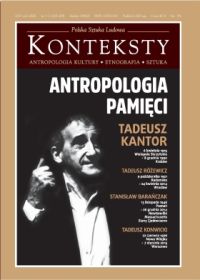Kantor – w kręgu lalek i manekinów
Kantor within the Array of Puppets and Mannequins
Author(s): Henryk JurkowskiSubject(s): Fine Arts / Performing Arts
Published by: Instytut Sztuki Polskiej Akademii Nauk
Keywords: Tadeusz Kantor;theatre;puppet;
Summary/Abstract: Tadeusz Kantor holds a distinctive position among theatrical artists opting for assorted figures (from mannequins to puppets and marionettes). having rejected the theories expounded by Kleist and Craig about the impersonal actor (mannequin, Übermarionette) Kantor conjured reflections pursued by Bruno Schulz, who in his Traktat o manekinachproclaimed theories about second demiurgic creation, associated with Kantor’s vision of “a reality of lower rank”. Kantor implemented his conceptions both during the initial period of “the autonomous theatre” and the end phase of “the theatre of death”. The figures and reistic images, which he introduced onto the stage, were not subjective since they were not complete stage characters although they signified more than commonplace props. The Kantor oeuvre coincides with a period of great interest in the impersonal actor, revealed in numerous attempts at its use by other artists working parallel to Kantor’s initiatives. Some exceeded him, as in the case of Meyerhold, who under the impact of the German Romantics often opted for the marionette style in his spectacles. Plebeian puppetry traditions (i.a. the commedia dell’arte) were revived slightly later by Armand Gaetti and Dario Fo. In her Théâtre du Soleil Ariane Mnouchkine was inspired by the Asian theatre, although its models served the creation of “European” metaphors.Numerous younger artists had already succumbed to the impact exerted by Kantor, such as Stephane Braunschweig, who in Chekhov’s The Cherry Orchard (Orleans, 1992) applied “the doubling of figures”. This principle also served the presentation of the inner world of the protagonists, e.g. in the works of Didier-Georges Gabin or Mathias Langhoff. Moreover, the impersonal actor evoked Enlightenment-era automatons, as in Don Giovanni (Geneva, 1991). Mechanical elements (albeit not exclusively) were introduced onto the stage by the Canadian artist Robert Lepage (in, i.a., The Far Side of the Moon,2000). It became apparent that the metaphorical force of the puppet and other forms of the impersonal actor is endless. Artists devised new applications, thus confirming the words of Jakub, a character from the prose by Bruno Schulz, in Street of Crocodiles (a spectacle staged by the Simon McBurney Théâtre de Complicité in 1992): “Matter remains in a state of incessant fermentation”.Numerous other examples of the application of figures, mannequins, and puppets include a long account of the spectacle War Horse (2007), directed by Tom Morris and Marianne Elliott (London) and dominated by a magnificent animated horse similar to Kantor’s “rider from a small legend”. The article ends with a presentation of new tendencies in the puppet theatre, which to a certain extent grows similar to the actor’s theatre: the activity of people comprises a backdrop for demonstrating puppets endowed with symbolic meanings.
Journal: Konteksty
- Issue Year: 308/2015
- Issue No: 1-2
- Page Range: 309-318
- Page Count: 10
- Language: Polish
- Content File-PDF

